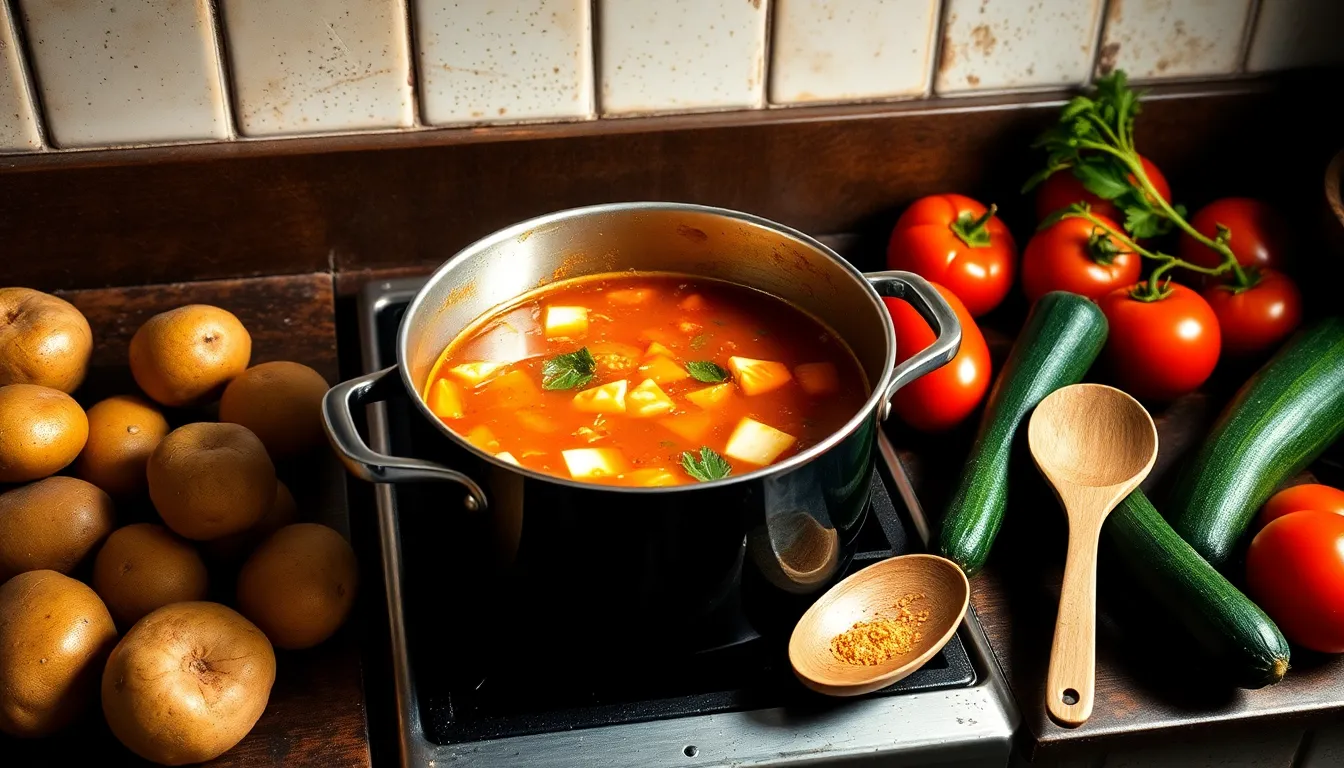Table of Contents
ToggleThere’s nothing worse than a bowl of soup that resembles a sad puddle instead of a hearty meal. If you’ve ever found yourself staring at a watery concoction, wondering how to turn it into a comforting delight, you’re in luck. Thickening soup is an art form that can elevate your culinary game and impress even the pickiest eaters.
Understanding Soup Consistency
Soup consistency plays a vital role in both texture and flavor. A well-thickened soup enhances the overall experience by providing a satisfying mouthfeel. Various factors influence how thick or thin a soup becomes. The ingredients used, cooking methods applied, and added thickeners all contribute to this essential aspect.
Liquid to solid ratios significantly affect consistency. For example, a higher ratio of solid ingredients, such as vegetables or proteins, results in a thicker soup. Conversely, excessive liquid can lead to a watery outcome. Mastering the right ratios ensures a perfect blend.
Thickness can also be adjusted during cooking. Simmering allows excess liquid to evaporate, leading to a richer texture. On the other hand, stirring in thickening agents at any stage can correct unwanted thinness. Examples of thickening agents include flour, cornstarch, and pureed vegetables.
Another important consideration revolves around the desired outcome. Creamy soups, for instance, typically contain cream or milk, which add richness and body. Chunky soups may rely on more solid ingredients to create a hearty feel. Each type of soup calls for different approaches to achieve the right consistency.
Understanding the balance between liquid and solids enables better control over the final product. Soups can transform with minor adjustments, catering to personal preferences. Achieving that perfect thick consistency can greatly enhance the enjoyment of each bowl served.
Common Reasons for Thin Soup

Thin soup often results from various factors, including choices of ingredients and cooking techniques. Understanding these aspects can help achieve the perfect consistency.
Ingredients Choices
Ingredient selection plays a significant role in soup thickness. Using low-starch vegetables, like zucchini and tomatoes, typically leads to thinner results. On the other hand, starchy ingredients such as potatoes, rice, or beans contribute to a creamier texture. Selecting broth over water enhances flavor but may not add thickness. Using fewer solid ingredients, or an excessive amount of liquid compared to solids, results in a watery soup. A well-balanced ratio between liquid and solids improves overall consistency, making it essential to consider ingredient choices carefully.
Cooking Techniques
Cooking methods significantly influence soup consistency. Cooking soup too quickly can trap moisture, so longer cooking times at lower temperatures allow for better evaporation. Simmering allows excess liquid to evaporate, thickening the soup effectively. Blending some of the soup creates a creamy texture while retaining chunky elements. Additionally, adding thickening agents, like cornstarch or roux, at the right stage in cooking can help achieve desired thickness. Adjusting the cooking time and applying the right techniques leads to a more satisfying and flavorful soup.
Methods to Thicken Up Soup
Various techniques exist to effectively thicken soup. Choosing the right method depends on desired flavor and texture.
Using Starches
Starches enhance soup thickness while providing a hearty feel. Common options include potatoes, rice, cornmeal, and tapioca. Adding mashed potatoes or cooked rice to the soup incorporates natural starch. Alternatively, a slurry made from cornstarch and water can be mixed into the simmering soup for quick thickening. Adjust the amount based on the soup’s volume; typically, one tablespoon of cornstarch per cup of liquid suffices. The result is a creamy, satisfying consistency that elevates the dish.
Incorporating Creams and Dairy
Creams and dairy can significantly improve soup texture and richness. Whole cream, half-and-half, milk, or yogurt adds both flavor and thickness. Whisk in these ingredients during the last stages of cooking to prevent curdling. Using sour cream not only thickens but also provides a tangy contrast to the soup’s flavors. Aim for about a cup of cream for every quart of soup, adjusting based on personal taste. This method transforms simple soups into decadent, comforting meals.
Blending Ingredients
Blending parts of the soup creates a smooth, creamy mixture. Utilizing an immersion blender or a countertop blender, puree a portion of the soup, then return it to the pot. This method is especially effective with thick vegetable soups or chowders. By blending, the soup gains volume and a luscious texture without added ingredients. Portions can vary, but pureeing one-third to half of the soup generally suffices. This technique works well with starchy vegetables like potatoes or legumes, enhancing overall body and flavor.
Tips for Achieving the Perfect Texture
Achieving the right soup texture requires attention to various elements. Timing and temperature play a critical role in thickening techniques.
Timing and Temperature
Long simmering times at low temperatures encourage evaporation. Consistent heat allows flavors to meld while reducing excess liquid. Monitoring the cooking time helps in achieving the preferred thickness without burning ingredients. Adjusting temperature during cooking provides better control over the thickening process. Rapid boiling may dilute the flavor and affects texture. When using starches, add them gradually and allow time for thickening before serving.
Seasoning Considerations
Seasoning profoundly affects the overall experience of a thickened soup. Careful measurement of salt and spices ensures that flavors balance with the added thickness. Adding salt too early can draw out moisture, impacting consistency. Incorporate herbs and aromatics towards the end for full flavor expression. Tasting throughout the cooking process helps adjust seasoning that complements the texture. Try different spices to enhance flavor without overpowering the soup’s natural essence. Subtle seasoning adjustments lead to a more enjoyable dining experience.
Thickening soup transforms it from a simple dish into a delightful experience. By understanding the balance of ingredients and employing effective techniques, anyone can elevate their soup’s consistency and flavor. Choosing the right thickening agents and cooking methods is essential for achieving that perfect texture.
With careful attention to timing and seasoning, each bowl can become a comforting meal that satisfies the palate. Whether it’s a hearty stew or a creamy bisque, mastering these skills will ensure that every soup is a hit at the dinner table. Embracing these strategies will not only impress guests but also make home-cooked soups a favorite staple.





